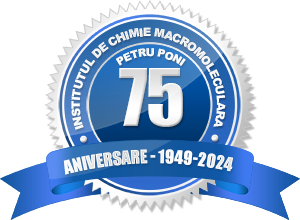⁕ Scientific reports
Stage I (2020) and Stage II (2021)
In Stage I (2020) and Stage II (2021) of the EngEChrom, 2 new diamines based on phenoxazine (POZ) and 1 based on phenothiazine (PTZ) were synthesized and structurally characterized. These diamines integrate triphenylamine (TPA) into a double electron donor topology to reduce the oxidation potential. The chemical structure of diamines, as well as the intermediates, was confirmed by 1H‒ (proton) and 13C‒ (carbon) NMR (nuclear magnetic resonance) spectroscopy and Fourier Transform infrared spectroscopy (FTIR). Proton and carbon NMR confirmed the structure and a 99% purity. In the proton NMR spectrum, the diamines showed typical signals attributed to the presence of amino groups and other aromatic and aliphatic structural elements that highlighted the presence of POZ and TPA units. The carbon NMR spectrum highlights the amino groups by the presence of the signal at about 145 ppm. Moreover, in the FTIR spectrum, diamine showed the absorption bands characteristic of the amino functional group. Based on them, polymers were synthesized as electroactive layers for prototype EC devices, which were synthesized by the polycondensation reaction to obtain 1 polyimide, 1 polyazomethine and 4 polyamides. These were grouped in two series to evaluate, first and foremost, the most advantageous class of polymers from the physico-chemical and electrochromic point of view, and secondly, the identification of the reaction counterparts from the same class of polymers that would lead to the most advantageous results. The chemical structure of the polymers was confirmed by spectral methods such as proton NMR and FTIR, and the structural elements typical of each class of polymers were identified. The thermal properties of the polymers were evaluated by differential scanning calorimetry (DSC) and thermogravimetric analysis (TGA). The the glass transitions of the polymers were in the temperature range typical of the classes to which they belong. Also, all polymers showed excellent thermal stability, as expected for these classes of polymers. Therefore, the recorded values successfully meet the requirements for using these polymers as electroactive layers in EC devices. The quality and morphology of thin polymer films were studied by scanning electron microscopy (SEM), and the images showed that they were smooth and homogeneous, without cracks or pinholes. Both basic and excited state geometries were obtained by DFT and TD‒DTF, involving the functional B3LYP together with the basic set 6-31 G(d,p), in order to identify the distribution of HOMO and LUMO orbitals and to evidence the main transitions from the experimental UV-Vis spectra. Thus, the n-π* transitions corresponding to the TPA and POZ units were identified, as well as those from two transitions associated with the charge transfer complex (CTC) between the TPA and POZ units and the electron acceptors. Except for polyazomethine, all synthesized polymers showed low absorption in the visible range of the electromagnetic spectrum, making them ideal for EC devices. In the anodic scan, the polymers showed two reversible REDOX waves with excellent stability even after 100 repetitive cycles, corresponding to the oxidation processes of POZ and TPA, respectively. Spectroelectrochemistry measurements have shown the variation of the absorption bands as the potential increased, being associated with the formation of cationic radicals and dicationic species. These spectral changes were also accompanied by the change of the films' color to green and blue. Based on two polymers with the best performance and physico-chemical characteristics, 2 EC prototype devices were assembled. The obtained results were rigorously analyzed, the structure-property-efficiency correlations were established, the construction technology of the devices was optimized, and the electrochromic performances and stability were evaluated. The results showed an electrochromic efficiency of up to 312 cm2/C. Also, the recovery of the electrochromic effect of the devices was up to 98% after 100 cycles. The results of Stage I and Stage II of EngEChrom were disseminated by 4 oral presentations and 1 poster at 4 international scientific events, and 2 papers published in ISI-indexed journals. Also, a dedicated web page was created on the official website of the host institution, which offers high visibility and serves as a tool for the dissemination of the results throughout the project.
⁕ Publications
- Catalin-Paul Constantin,* Gabriela Lisa, and Mariana-Dana Damaceanu. Assessing the Electrical Characteristics of p−n Heterojunction Prototype Diodes Realized with n‑Type Polyimide Materials. Macromolecules, 54, 941−957 (2021) https://doi.org/10.1021/acs.macromol.0c01853
- Catalin-Paul Constantin, Mihai Asandulesa, Cristian Varganici, Violeta Melinte, Maria Bruma, Andrzej Jankowski, Aleksandra Wolinska-Grabczyk, Mariana-Dana Damaceanu*. Exploring the potential of thin films made from poly(imide-amide-sulfone)s for engineering applications. Materials Science & Engineering B, 270, 115217 (2021)
https://doi.org/10.1016/j.mseb.2021.115217
⁕ Conferences
- Catalin-Paul Constantin, Andra-Elena Bejan, Mariana-Dana Damaceanu. Synthesis and characterization of new triphenylamine-based polyimides for electrochromic applications. 2nd Bucharest Polymer Conference Bucharest (BPC2020), June 9-11, 2021, Bucharest, Romania.
- Irina Butnaru, Catalin-Paul Constantin, Mariana-Dana Damaceanu. Polyimides containing bipyridyl-amine functionalized triphenylamine as electrochromic materials. 12th International Conference on Physics of Advanced Materials (ICPAM-13), September 24 – 30, 2021, Sant Feliu de Guixols, Spania.
- Catalin-Paul Constantin, Andra-Elena Bejan, Mariana-Dana Damaceanu. Effect of dianhydride segment structure on the electrochromic properties of novel triphenylamine-based polyimides. New trends and strategies in the chemistry of advanced materials with relevance in biological systems, technique and environmental protection, 13th Edition, online, October 7 – 8, 2021, Timisoara, Romania.
- Mariana-Dana Damaceanu, Catalin-Paul Constantin, Andra-Elena Bejan, Cristian Logigan. Recent concepts in electrochromic polymers containing triarylamine as electroactive unit. Progress in Organic and Macromolecular Compounds, 28th Edition, International Conference, October 7 – 9, 2021, Iasi, Romania.
⁕ Posters
- Catalin-Paul Constantin, Andra-Elena Bejan, Mariana-Dana Damaceanu. Electrochromic prototype devices based on triphenylamine-triphenylmethane containing polyimides. 12th International Conference on Physics of Advanced Materials (ICPAM-13), September 24 – 30, 2021, Sant Feliu de Guixols, Spania.
|








